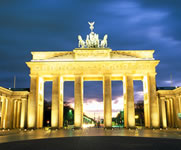You do not have to be asked twice when the table is set with the elegant Nymphenburg or Ludwigsburger porcelain. Or when, as the culmination, steaming coffee is poured from a Meißen coffee-pot into cups with the world famous onion pattern. And very often you will come upon the famous bone china from Villeroy & Boch - the elegant designs of the Chateau range, as well as the cheerful pattern of House & Garden. Just as in the Saarland, Rosenthal also moves with the times, having engaged artists like Gianni Versace or Jasper Morrison.
On the table of Culinary Germany drinks also come in style. Pilsener beer sports its proudest head only in an elegant flute. And turning to wine: the Riesling you drink with your fish sparkles green in a cut crystal glass and sekt (German sparkling wine) bubbles perfectly in a long-stemmed flute.
Porcelain factories, silversmiths and glass works have a glorious tradition in Germany. Finely fashioned table settings and silverware, which in former times were reserved for royalty alone, now decorate the dining tables of restaurants and hotels. A valuable addition to the diverse range of fine china is a variety of delicate sculptures. The filigree ballerinas and harlequins, fired in the best kilns of the country, are precious souvenirs just like the pleasingly plump Hummel figures of the Bavarian Franciscan nun Maria Innocentia.
On our culinary routes we find companies with famous names. They welcome visitors and are happy to show what they produce. Often there is a museum and attractive shopping possibilities directly from the manufacturer (factory sale). Saalfeld in Thuringia is surrounded by the Porcelain Route and entices you to look and buy. This is also true of the glass works which line the Glass Route, which runs 250 kilometres through the Bavarian and Oberpfälzer Forests. This is the largest undivided forest mountain range in central Europe. And whenever you stop a ready laid table is waiting for you.




